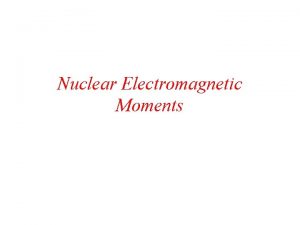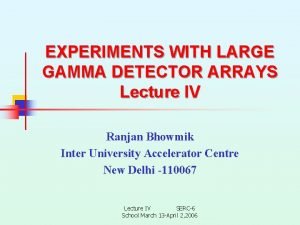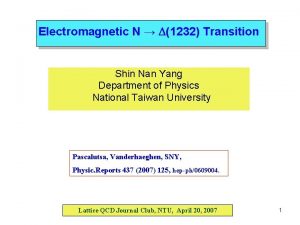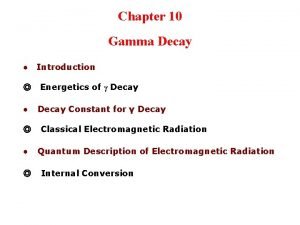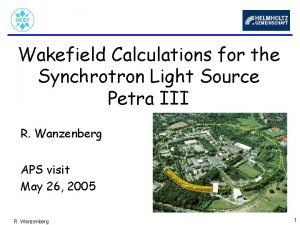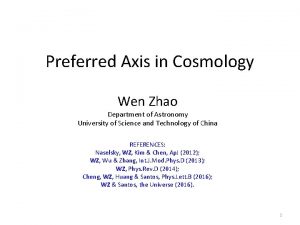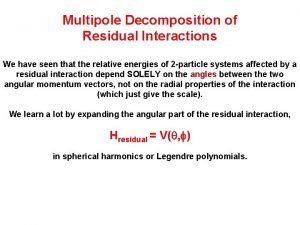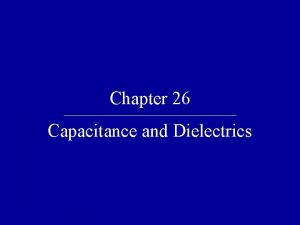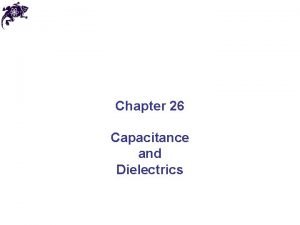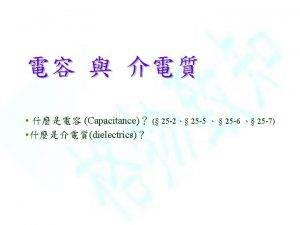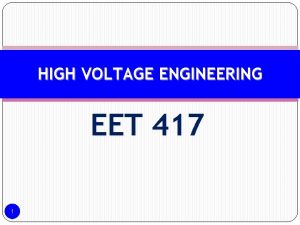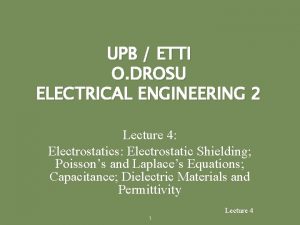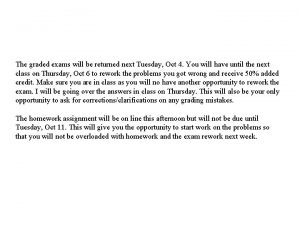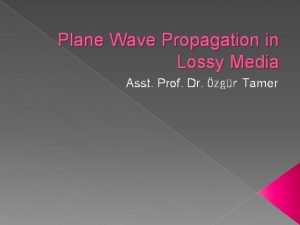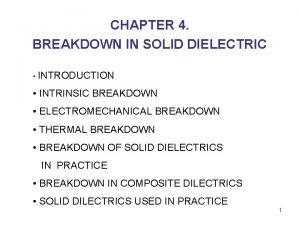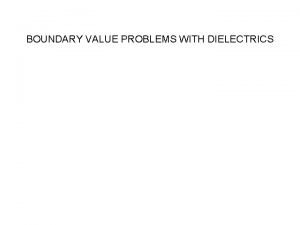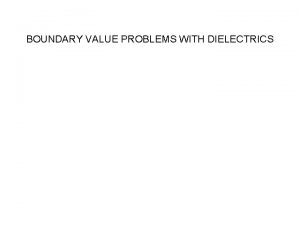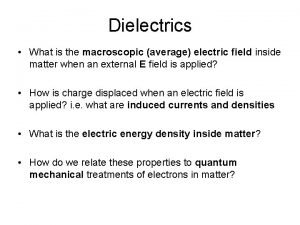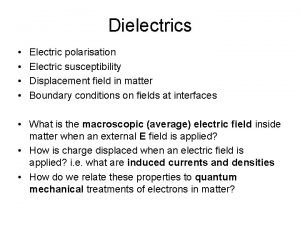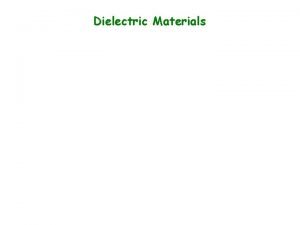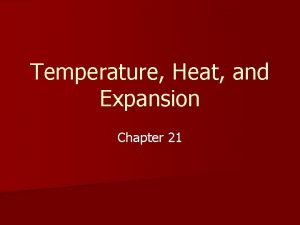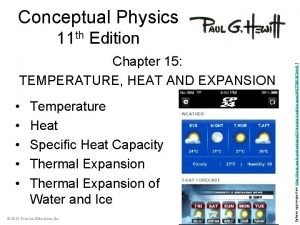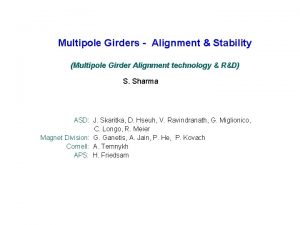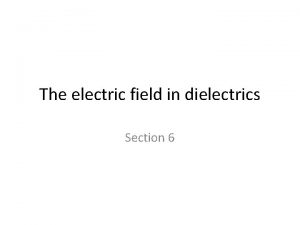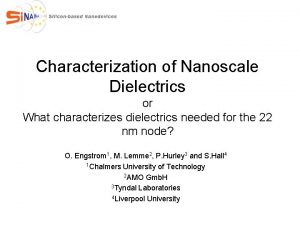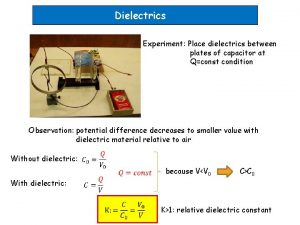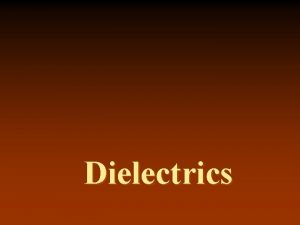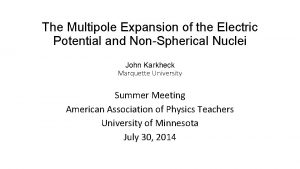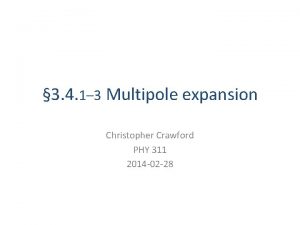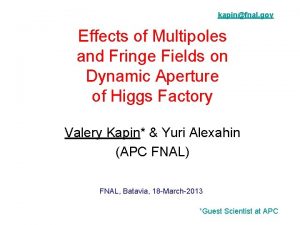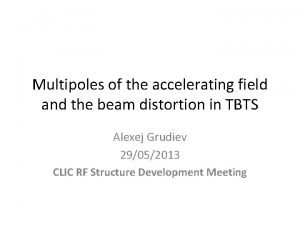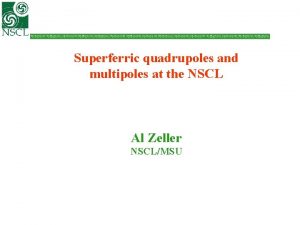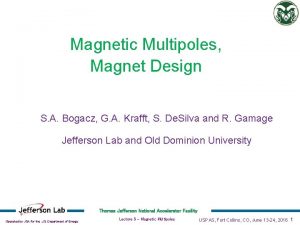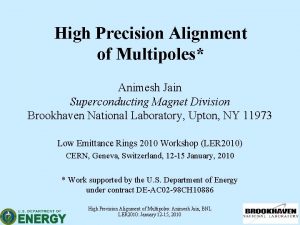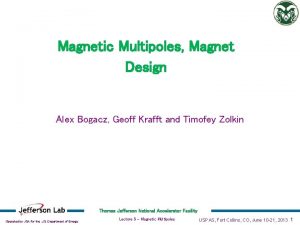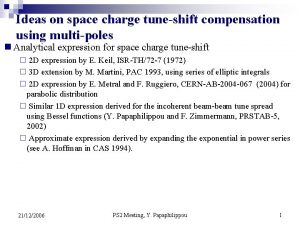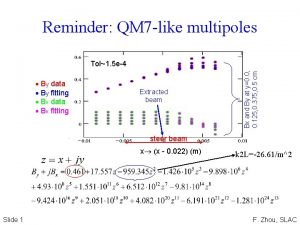4 Multipoles and Dielectrics 4 A Multipole Expansion


































- Slides: 34

4. Multipoles and Dielectrics 4 A. Multipole Expansion Revisited Switching to Cartesian Coordinates • Before we defined the multipole moments of a charge distribution • Let’s work out these explicitly for l = 1, 2, 3 • Write it out in Cartesian coordinates

Dipole and Quadrupole Moment • Define total charge • Dipole moment • Quadrupole moment • Then the multipole moments can be written • Contains same information as the qlm’s

The Potential in Terms of p’s and Q’s • The potential is then • Substitute in the qlm’s and write out the potential explicitly • We find: Comments: • The multipole moments depend on choice of origin • If you shift the charge distribution by an amount a, these components shift by • • So the leading order non-vanishing term is independent of choice of origin Note that qlm’s have 2 l + 1 different components for each value of l q and p have 1 and 3 components, and Q seems to have six components It has only 5 independent components because

Electric Field from a Dipole • Consider a dipole oriented in an arbitrary direction • The electric field will be: • We can put it at an arbitrary point x 0 instead of the origin • n is unit vector from x 0 to x

Energy in Terms of Multipole Moments • A charge distribution in a background potential has energy • If the potential changes slowly in a region with no other charge, then • Substituting in, we find • Since no charge, • We therefore have

Energy, Dipoles, and Torque • Recall that E = – • A dipole’s energy depends only on electric field • For example, the energy between two dipoles will be given by • An object feels torque when energy depends on angle • The torque is related to energy by • If you write it as a vector, this works out to • Torque tries to make dipole align with E-field

Sample Problem 3. 1 Two dipoles have identical dipole moments p oriented in the z-direction. If they are separated by a distance r at an angle compared to the z-axis, find the force on one. • Energy of two dipoles: • Force on upper dipole: r

Sample Problem 3. 2 (1) A molecule in a dilute gas has dipole moment of magnitude p and is at temperature T. What is the expectation value of the dipole moment in the presence of an electric field E in the z-direction? If the electric field is weak, show that it is proportional to E • Need to know some statistical mechanics • Because it is a gas, presumably the molecules don’t interact with each other • Label states by i, with energy Wi and some quantity of interest fi in state i, then – Where = 1/k. BT • The states in this case are all possible angles, so • Polarization will be • The energies are • So we have

Sample Problem 3. 2 (2) A molecule in a dilute gas has dipole moment of magnitude p and is at temperature T. What is the expectation value of the dipole moment in the presence of an electric field E in the z-direction? If the electric field is weak, show that it is proportional to E • Do the integral – x and y directions vanish

Sample Problem 3. 2 (3) A molecule in a dilute gas has dipole moment of magnitude p and is at temperature T. What is the expectation value of the dipole moment in the presence of an electric field E in the z-direction? If the electric field is weak, show that it is proportional to E • Strong field limit: Ep >> 1 • Weak field limit: Ep << k. BT:

4 B. Dielectrics Space Averaging • The formulas at right can be use as descriptions of the microscopic fields • In the presence of materials, there can be very large electric fields inside • For example, 0. 1 nm from a proton, the electric field is • • Much larger than external fields that we would normally encounter They also vary spatially very quickly These don’t really interest us very much To get rid of them, do some space averaging – On a scale large compared to atoms • Then easy to show

Dealing With Bound Charges Now, there are two contribution to electric fields • Net charge that is in conductors, insulators, or free charges • Net neutral charges in insulators, or bound charges b • The bound charges would normally have no net charge, so think of it as overlapping regions of cancelling charge: • Because the charges cancel, normally any volume would have Qb(V) = 0 • But if the charge density of type i shifts by an amount di(x), then a small part of the charge may leave the volume • At a point on the surface x, if there is displacement di(x), then dot this into the normal to find the amount of charge leaving the volume • Add it up over the surface

Electric Polarization and Electric Displacement • Define the electric polarization • Then the bound charge in a volume V is • Use divergence theorem • The bound charge in a volume is also • Therefore, • We note that • Define the electric displacement as • Then in macroscopic media, we have

Constitutive Equations • These two equations alone are not generally sufficient to find E and D • We need to find a relationship between E and D • Normally, P will be a function of E – Not always! – This is called a constitutive equation • For not too large a field, you can generally Taylor expand P: • Almost never does the first term contribute • Give these coefficients names: • For most materials you can use parity to argue second term vanishes • Third term is negligible unless electric field is really big

Susceptibility and Dielectric Constant • The constant ij are the electric susceptibility tensor – Can be shown it is symmetric • If it is not proportional to the identity matrix, then P will not be parallel to E – This does happen in lots of interesting crystals P E • However, it will be parallel in liquids, gasses, amorphous solids, and many crystals – Such as those with cubic symmetry • We then define the dielectric constant • Then we have: • When this is true, then

Sample Problems 3. 3 Redo all previous problems if we replace vacuum with a material with dielectric constant . • We previously were effectively solving: • Now we are solving: • Solution: copy all previous answers and replace 0 by

Comments on Susceptibility • Air and other gases have susceptibility that are small, so • Liquids and solids can have susceptibilities of order 1, or even much higher • Under ordinary circumstances (at zero frequency), • Later we will often be working with oscillating fields • Then the susceptibility can depend on the frequency • It can even be complex! – We’ll find out what that means later

Gauss’s Law, Potential, etc. • Since E = 0, we still can write But we must redo Gauss’s Law: • Consider the charge in any volume V • Use the divergence theorem:

Discontinuity at a Boundary Consider a surface (locally flat) with a free surface charge • How do E and D change across the boundary? A L • Consider a small thin box of area A –L crossing the boundary • Since it is small, assume D is constant over top surface and bottom surface • Use Gauss’s Law on this small box • Charge inside the box is A • Since box is thin, ignore lateral surface • Normally, no charge on such a surface • Consider a small loop of length L penetrating the surface • Use the identity • Ends are short, so only include the lateral part

Dielectric Next to Conductor • Conductors have E = D = 0 inside D • Since E|| is continuous, E|| = 0 in the dielectric • Since D = , we would have D = in the dielectric • If D E, then

Bound Charges • When we are in a homogenous, isotropic medium, in a region with no free charge, • The bound charge is given by • • No bound charges in interior of homogenous isotropic regions if no free charge On the surface, there will be bound charges Consider a small, thin box of area A penetrating the surface The charge inside will be A • • Use the divergence theorem Lateral surface is small No polarization on the exterior Normal vector n on box is opposite to normal vector to surface

Sample Problems 3. 4 (1) A conducting sphere of radius a with charge Q on it is surrounded by a dielectric with dielectric constant of radius b. Find the E, D, and the potential everywhere, and the surface bound charge at b. • Inside the conductor, E = D = 0 • By symmetry, D and E are radially outwards and depend only on distance r from the center • Gauss’s law applied to any sphere outside the conductor: • In both vacuum and the dielectric, D and E are proportional, so • While we’re at it, let’s get the bound surface charge density: Q

Sample Problems 3. 4 (2) A conducting sphere of radius a with charge Q on it is surrounded by a dielectric with dielectric constant of radius b. Find the E, D, and the potential everywhere, and the surface bound charge at b. • Find the potential from • Clearly, potential will depend only on r, so • Integrate • We want ( ) = 0, so C 1 = 0 • We want it continuous at r = b, so Q

4 C. Solving Problems with Dielectrics Guess and Check • It is generally hard to find exact solutions to problems with dielectrics • “Guess and check” will often work, if you can make a good guess How does one make intelligent guesses? • In the limit = 0, a dielectric acts like vacuum • In the limit = , a dielectric acts like a conductor • Often, can use conductors as inspiration D D What do you have to check in problems with dielectrics? • Always must have E = 0 and D = within any region – Usually automatic for the right guesses • On dielectric boundaries, must have: E|| and D continuous • E|| continuous can be enforced by having a continuous potential • On conducting boundaries, must have E|| = 0 (equivalent to constant) E|| E

Sample Problems 3. 5 (1) Two long coaxial cylinders of radii a and b are half-filled with a dielectric with dielectric constant between them. If a charge per unit length is put on the inner one and – on the outer one, find the voltage difference • • Guess: fields (E or D) will be radial outwards Guess: within each region they probably depend on just r Q: Which one of the following makes sense? The fields are parallel at the boundary Therefore E will be continuous across it So E is the one that works So the displacement field is: • Now use Gauss’s Law on a cylindrical surface of radius r and length L b a

Sample Problems 3. 5 (2) Two long coaxial cylinders of radii a and b are half-filled with a dielectric with dielectric constant between them. If a charge per unit length is put on the inner one and – on the outer one, find the voltage difference Is our answer correct? • It’s proportional to the answer without the dielectric, so clearly within each region • And therefore • E|| is continuous across the boundary • D = 0 is continuous at the boundary • E|| = 0 at the conductors • So it is correct • The potential difference is then b a

Point Charge With Two Dielectrics q • Suppose you have a point charge q a distance h above a dielectric region, so all of z < 0 has constant h • If it were a conductor instead, we would have: – Charge q at z = h plus image charge –q at z = – h for z > 0 – No field at all for z < 0 h • If it were vacuum instead, we would have q' – Charge q at z = h for z > 0 – Charge q at z = h for z < 0 • We guess that the correct solution is somewhere between these extremes • For z > 0, conjecture original charge at z = h and image charge q' at z = –h • For z < 0, it looks like original charge diminished to q'' at z = +h

Guess and Check q h We have a conjectured form for the fields, but is it right? • In the region z > 0, this is field from two charges, so we would automatically have: • In the region z < 0, we have • Still have to check boundary conditions! h q'

Matching at the Boundary q h • Electric fields at the boundary are: h q' • Match E|| at boundary: • Match D at boundary: • Two equation in two unknowns

Sample Problems 3. 6 (1) A dielectric sphere of radius a and dielectric constant is placed in a uniform electric field of magnitude E. Find the potential everywhere. • • Let’s do this with potentials Let external field be in the z-direction, then The external potential is We know the solution for a conducting sphere: • And the solution for = 0: • We therefore conjecture a solution of the form:

Sample Problems 3. 6 (2) A dielectric sphere of radius a and dielectric constant is placed in a uniform electric field of magnitude E. Find the potential everywhere. • We have no free charge, so in regions of constant , we need • The general solution to this in spherical coordinates is • By inspection, will satisfy Laplace’s equation • It clearly has correct asymptotic value as r • The potential must be continuous at r = a, so • Since continuous, it will automatically satisfy E|| continuous • We still have to match D

Sample Problems 3. 6 (3) A dielectric sphere of radius a and dielectric constant is placed in a uniform electric field of magnitude E. Find the electric field everywhere. • We calculate D in each region: • Solve the equations:

4 C. Energy in the Presence of Dielectrics One Step at a Time • Suppose we have a collection of dielectrics, initially with no charges • Now imagine adding some charge free charges (x) a little at a time • The work required is • The small change in charge causes a change in D: • Use product rule • Use divergence theorem and fact that • Potential at infinity is zero, so

Necessity of Linearity • Now, assume the response is linear: • Then we have • And therefore: • Add up all the little charges – Assume that W = 0 if there is no fields • If desired, you can integrate by parts again to get an equivalent formula • Both of these formulas, however, assume linearity.
 Multipole
Multipole Multipole expansion of magnetic vector potential
Multipole expansion of magnetic vector potential Electric multipoles
Electric multipoles Multipole radiation
Multipole radiation Nan-f--app8 -site:youtube.com
Nan-f--app8 -site:youtube.com Multipole radiation
Multipole radiation Multipole
Multipole Multipole
Multipole Cmb multipole
Cmb multipole Multipole decomposition
Multipole decomposition Capacitance and dielectrics quiz
Capacitance and dielectrics quiz Capacitance and dielectrics
Capacitance and dielectrics Polar and non polar dielectrics
Polar and non polar dielectrics Difference between pure liquid and commercial liquid
Difference between pure liquid and commercial liquid Treeing and tracking in solid dielectrics
Treeing and tracking in solid dielectrics Gauss law in differential form
Gauss law in differential form Gauss law in dielectrics
Gauss law in dielectrics The attenuation constant in lossless dielectrics will be
The attenuation constant in lossless dielectrics will be Dielectric conductor
Dielectric conductor Intrinsic breakdown in solid dielectrics
Intrinsic breakdown in solid dielectrics Boundary
Boundary Boundary value problems with dielectrics
Boundary value problems with dielectrics Average electric field
Average electric field What is electric susceptibility
What is electric susceptibility What is dielectric materials
What is dielectric materials Westward expansion lewis and clark
Westward expansion lewis and clark Relocation diffusion vs expansion diffusion
Relocation diffusion vs expansion diffusion Thermal expansion and contraction examples
Thermal expansion and contraction examples Chapter 21 temperature heat and expansion answer key
Chapter 21 temperature heat and expansion answer key Effects of business expansion conglomerates and franchises
Effects of business expansion conglomerates and franchises Module 10 expansion exploration and encounters
Module 10 expansion exploration and encounters Unit 3 rev. statehood and westward expansion
Unit 3 rev. statehood and westward expansion Chapter 15 temperature heat and expansion
Chapter 15 temperature heat and expansion Lesson 1 slavery and western expansion
Lesson 1 slavery and western expansion Branch expansion programme and policy
Branch expansion programme and policy


